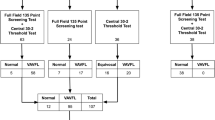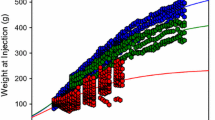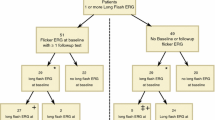Abstract
Purpose: To compare the visual electrophysiology and visual fields of patients taking vigabatrin to those of a control group of epileptics on other anti-epileptic drugs (AEDs). Methods: Fourteen epileptics treated with vigabatrin and 10 control patients treated with other AEDs underwent ERG and EOG. Goldmann visual fields were performed and analysed using standard software to measure areas contained within I4e isopters. Results: The cone and rod b-waves of the ERG, the oscillatory potential amplitudes and Arden indices were reduced in vigabatrin-treated subjects and the oscillatory potentials delayed. The Arden indices were reduced due to an increased dark trough. The areas contained within the I4e isopter of vigabatrin treated subjects were reduced compared to the control group and these areas correlated well with oscillatory potential amplitudes and b-wave amplitudes in the vigabatrin group only. Conclusions:The use of vigabatrin is associated with a reduction of the ERG cone b-wave amplitude and oscillatory potentials which correlates with visual field loss. The Arden ratio is reduced in subjects taking vigabatrin but may recover after cessation. However, visual loss may persist in the presence of a recovered EOG. These findings suggest further effects of the drug than those mediated by GABA receptors, and support the contention that the cause of the field loss may be at least in part due to retinal effects. Possible mechanisms are discussed.
Similar content being viewed by others
References
Meldrum BS. The role of glutamate in epilepsy and other CNS disorders. Neurology 1994; 44(11 Suppl 8): S14–23
De Luka SR, Protic S, Vrbaski SR. Gamma aminobutyric acid - its function, disorders and their sequelae. Med Pregl 1998; 51(7-8): 319–24
Frumkes TE, Nelson R. Functional role of GABA in cat retina: I. Effects of GABA(A) agonists. Vis Neurosci 1995; 12(4): 641–50
Frumkes TE, Nelson R, Pflug R. Functional role of GABA in cat retina: II. Effects of GABA(A) antagonists. Vis Neurosci 1995; 12(4): 651–61
Gibson KM, Hoffmann GF, Hodson AK, Bottiglieri T, Jakobs C. 4-Hydroxybutyric acid and the clinical phenotype of succinic semialdehyde dehydrogenase deficiency, an inborn error of metabolism. Neuropediatrics 1998; 29(1): 14–22
De Biase D et al. Chemistry of the inactivation of 4-aminobutyrate aminotransferase by the antiepileptic drug vigabatrin. J Biol Chem 1991; 266(30): 20056–61
Loscher W, Horstermann D. Differential effects of vigabatrin, gamma-acetylenic acid, and valproate on levels of various amino acids in rat brain regions and plasma. Naunyn Schmiedebergs Arch Pharmacol 1994; 349(3): 270–8
Bernasconi R, Klein M, Martin P, Christen P, Hafner T, Portet C, Schmutz M. Gammavinyl GABA: comparison of neurochemical and anticonvulsant effects in mice. J Neural Transm 1988; 72(3): 213–33
Sidhu RS et al. Low-dose vigabatrin (gamma-vinylGABA)-induced damage in the immature rat brain. Exp Neurol 1997; 144(2): 400–5
Mackenzie R, Klistorner A. Severe persistent visual field constriction associated with vigabatrin: asymptomatic as well as symptomatic defects occur with vigabatrin, (Letter), Br Med J 1998; 316: 233
Wilson EA, Brodie MJ. Severe persistent visual field constriction associated with Vigabatrin: chronic refractory epilepsy may have role in causing these unusual lesions (Letter). BMJ 1997; 314: 1693
Eke T, Talbot JF, Lawden MC. Severe persistent visual field constriction associated with Vigabatrin. BMJ 1997; 314: 180–1
Wong ICK, Mawer GE, Sander JWAS. Severe persistent visual field constriction associated with vigabatrin: reaction might be dose dependent (Letter) BMJ 1997; 314: 1693–4
Wild JM, Martinez C, Reinshagen G, Harding GF. Characteristics of a unique visual field effect attributed to vigabatrin. Epilepsia 1999; 40(12): 1784–94
Harding GFA. Severe persistent visual field constriction associated with vigabatrin: four possible explanations exist (Letter). BMJ 1997; 314: 1694
Kalvainen R et al. Vigabatrin, a gabaergic anti-epileptic drug, causes concentric visual field defects. Neurology 1999; 53(5): 922–6
Wohlrab G et al. Visual field constriction is not limited to children treated with vigabatrin. Neuropediatrics 1999; 30(3): 130–2
Nordmann JP, Baulac M & Van Egroo C. Concentric changes in the visual field associated with GABA-mimetic anti-epileptic agents. J F Ophthalmol 1999; 22(4): 418–22
Bayer A, Thiel HJ, Zrener E, Paulus W, Ried S, Schmidt D. Disorders of colour perception and increase glare sensitivity in phenytoin and carbamazepine therapy. Nervenarzt 1995; 66(2): 89–96
Miller NR, Johnson MA, Paul SR, Girkin CA, Perry JD, Endres M, Krauss GL. Visual dysfunction in patients receiving vigabatrin: clinical and electrophysiologic findings. Neurology 1999; 53(9): 2082–7
Marmor MF, Zrenner E. Standard for clinical electroretinography. Doc Ophthalmol 1995; 89: 199–210
Galloway NR, Barber C. Automated electro-oculography. Trans OSUK 1973; 93: 269–275
Daneshvar H et al. Symptomatic and asymptomatic visual loss in patients taking vigabatrin. Ophthalmology 1999; 106(9): 1792–8
Lawden MC, Eke T, Degg C, Harding GF, Wild JM. Visual field defects associated with vigabatrin therapy. J Neurol Neurosurg Psychiatry 1999; 67(6): 716–22
Mizuno A, Kamada Y, Kunita M, Matsuda M. The effect of antivitamin B6 administration on gamma-aminobutyric acid metabolism in retina and electroretinogram. J Nutr Sci Vitaminol 1980; 26(1): 25–32
Citron MC, Erinoff L, Rickman DW, Brecha NC. Modification of electroretinograms in dopamine-depleted retinas. Brain Res 1985; 345(1): 186–91
Wachtmeister L. Oscillatory potentials in the retina: what do they reveal? Prog Retinal Eye Res. 1998; 17(4): 485–521
Janaky M, Goupland SG, Benedek G. Human oscillatory potentials: components of rod origin. Ophthalmologica 1996; 210(6): 315–8
Grobin AC, Matthews DB, Devaud LL, Morrow AL. The role of GABA(A) receptors in the acute and chronic effects of ethanol. Psychopharmacology (Berlin) 1998; 139(1-2): 2–19
Ruiz A, et al. A major locus for autosomal retinitis pigmentosa on 6q, determined by homozygosity mapping of chromosomal regions that contain gamma-aminobutyric acidreceptor clusters. Am J Hum Genet 1998; 62(6): 1452–9
Vaquero CF, de la Villa P. Localisation of the GABA( C) receptors at the axon terminal of the rod bipolar cells of the mouse retina. Neurosci Res 1999; 35(1): 1–7
Krauss GL, Johnson MA, Miller NR. Vigabatrin-associated retinal cone system dysfunction. Neurology 1998; 50(3): 614–8
Arndt CF, Derambure P, Defoort-Dhellemmes S, Hache JC. Outer retinal dysfunction in patients treated with vigabatrin. Neurology 1999; 52(6): 1201–5
John RA, Rimmer EM, Williams J, Cole G, Fowler LJ, Richens A. Microvacuolation in rat brains after long term administration of GABA-transaminase inhibitors. Biochem Pharmacol 1987; 36(9): 1467–73
Schechter PJ. Clinical pharmacology of vigabatrin. Br J Clin Pharmacol 1989; 27(Suppl 1): 19S–22S
Gibson KM, Nyhan WL, Jaeken J. Inborn errors of GABA metabolism. Bioessays 1986; 4: 24–27
Vallat C, Rivier F, Bellet H, Magnan de Bornier B, Mion H, Echenne B. Treatment with vigabatrin may mimic alpha-aminoadipic aciduria. Epilepsia 1996; 37(8): 803–5
Garner CD, Lee EW, Louis-Ferdinand RT. Muller cell involvement in methanol-induced retinal toxicity. Toxicity Appl Pharmacol 1995; 30(1): 101–7
Sherif FM, Tawati AM, Ahmed SS, Sharif SI. Basic aspects of GABA-transmission in alcoholism, with particular reference to GABA-transaminase (Review). Eur Neuropsychopharmacol 1997; 7(1): 1–7
Haugstad TS, Langmoen IA. L-alpha-aminoadipate reduces glutamate release from brain tissue exposed to combined oxygen and glucose deprivation. J Cereb Blood Flow Metab 1997; 17(5): 567–70
Roubertie A, Bellet H, Echenne B. Vigabatrin-associated retinal cone system dysfunction (letter). Neurology 1998; 51: 1779
Hassel B, Johannessen CU, Sonnewald U, Fonnum F. Quantification of the GABA shunt and the importance of the GABA shunt versus the 2-oxoglutarate dehydrogenase pathway in GABAergic neurons. J Neurochem 1998; 71(4): 1511–8
Manev H, Pericic D. Sex differences in the turnover of GABA in the rat substantia nigra. J Neurol Transm 1987; 70(3/4): 321–8
Matern D, Lehnert W, Gibson KM, Korinthenberg R. Seizures in a boy with succinic semialdehyde deficiency treated with vigabatrin (gamma-vinyl-GABA). JInherit Metab Dis 1996; 19(3): 313–8
Medina-Kauwe LK, et al. Identification of a familial mutation associated with GABA-transaminase deficiency disease. Neurobiol Dis 1998; 5(2): 89–96
Jakobs C, Jaeken J, Gibson KM. Inherited disorders of GABA metabolism. J Inherit Meb Dis 1993; 16(4): 704–15
Rivner MH, Shamsnia M, Swift TR, Trefz J, Roesel RA, Carter AL, Yanamura W, Hommes FA. Kearns-Sayre syndrome and Complex II deficiency. Neurology 1989; 39(5): 693–6
van Bemmelen FJ, Schouten MJ, Fekkes D, Bruinvels J. Succinic semialdehyde as a substrate for the formation of GABA. J Neurochem. 1985; 45(5): 1471–4
Manor D, et al. The rate of turnover of cortical GABA from (1-13C)-glucose is reduced in rats treated with the GABA-transaminase inhibitor vigabatrin (gamma-vinyl GABA). Neurochem Res 1996; 21(9): 1031–41
Halonen T, Pitkanen A, Riekkinen PJ. Administration of vigabatrin affects the levels of both inhibitory and excitatory amino acids in rat cerebrospinal fluid. J Neurochem 1990; 55(6): 1870–4
Halonen T, Lehtinen M, Pitkanen A, Ylinen A, Riekkinen PJ. Inhibitory and excitatory amino acids in CSF of patients suffering from complex partial seizures during chronic treatment with gamma-vinylGABA (vigabatrin). Epilepsy Res 1988; 2(4): 246–52
Duarte CB, Ferreira IL, Santos PF, Carvalho AL, Agostinho PM, Carvalho AP. Glutamate in life and death of retinal amacrine cells. Gen Pharmacol 1998; 30(3): 289–95
Chen Q, Moulder K, Tenkova T, Hardy K, Olney JW, Romano C. Excitotoxic cell death dependent on inhibitory receptor activation. Exp Neurol 1999; 160(1): 215–25
Hassel B, Sonnewald U. Selective inhibition of the tricarboxylic acid cycle of GABAergic neurons with 3-nitropropionic acid in vivo. J Neurochem 1995; 65(3): 1184–91
Reynolds NR, Lin W, Meyer Cameron C, Roerig DL. Differential responses of extracellular GABA to intrasriatal perfusions of 3-nitropropionic acid and quinolinic acid in the rat. Brain Res 1997; 778(1): 140–9
Gu M, Gash MT, Mann VM, Javoy-Agid F, Cooper JM, Schapira AH. Mitochondrial defect in Huntington's disease caudate nucleus. Ann Neurol 1996; 39(3): 385–9
Tunnicliff G. Centrally-acting drugs and the formation of brain gamma-aminobutyric acid. Gen Pharmacol 1976; 7(4): 259–62
Sawaya MC, Horton RW, Meldrum BS. Effects of anticonvulsant drugs on the cerebral enzymes metabolizing GABA. Epilepsia 1975; 16(4): 649–55
Garthwaite G, Brown G, Batchelor AM, Goodwin DA, Garthwaite J. Mechanisms of ischaemic damage to central white matter axons: a quantitative histological analysis using rat optic nerve. Neuroscience 1999; 94(4): 1219–30
Kobayashi N, Ishiguro S, Tomita H, Nishikawa S, Tamai M. Changes of GABA metabolic enzymes in acute retinal ischemia. Exp Eye Res 1999; 69(1): 91–96
Ishikawa A, Ishiguro S, Tamai M. Changes in GABA metabolism in streptozotocininduced diabetic rat retinas. Curr Eye Res 1996; 15(1): 63–71
Lopez L, Sannita WG. Glucose availability and the electrophysiology of the human visual system (Review). Clin Neurosci 1997; 4(6): 336–40
Lansel N, Niemeyer G. Effects of insulin under normal and low glucose on retinal electrophysiology in perfused cat eye. Invest Ophthalmol Vis Sci 1997; 38(5): 792–9
Hennekes R. Oscillatory potentials as an indicator of functional changes in diabetic retinopathy. Klin Monatsbl Augenheilkunde 1986; 189(5): 372–3
Petersen JS, Rimvall K, Jorgensesn PN, Hasselager E, Moody A, Hejnaes K, Clausen JT, Dryberg T. Regulation of GAD expression in rat pancreatic islets and brain by gammavinyl-GABA and glucose. Diabetologica 1998; 41(5): 530–5
Klooster J, Prins M, Wesseling T, de Hollander L, Kingma J, Schuchard Y, Kamphuis W. Localisation of ionotropic glutamate receptors in the human retina. Poster at European Vision & Eye Research Meeting, October 1999
Andrews RM, Griffiths PG, Johnson MA, Turnbull DM. Histochemical localisation of mitochondrial enzyme activity in human optic nerve and retina. Br J Ophthalmol 1999; 83(2): 231–5
Reichelt W, Stabel-Burow J, Pannicke T, Weichert H, Heinemann U. The glutathione level of retinal Muller cells is dependent on the high-affinity sodium-dependent uptake of glutamate. Neuroscience 1997; 77(4): 1213–24
Kato S et al. Cystine/glutamate antiporter expression in retinal Muller glial cells: implications for dl-alpha-aminoadipate toxicity. Neuroscience 1993; 57(2): 473–82
Zeevalk GD, Bernard LP, Sinha C, Ehrhart J, Nicklas WJ. Excitotoxicity and oxidative stress during inhibition of energy metabolism. Dev Neurosci 1998; 20(4-5): 444–53
Author information
Authors and Affiliations
Rights and permissions
About this article
Cite this article
Comaish, I., Gorman, C., Brimlow, G. et al. The effects of vigabatrin on electrophysiology and visual fields in epileptics: a controlled study with a discussion of possible mechanisms. Doc Ophthalmol 104, 195–212 (2002). https://doi.org/10.1023/A:1014603229383
Issue Date:
DOI: https://doi.org/10.1023/A:1014603229383




